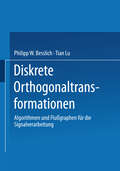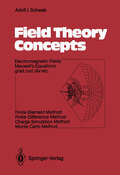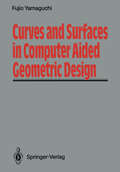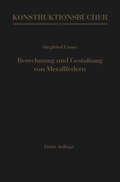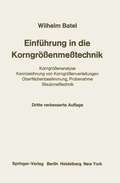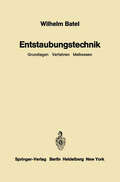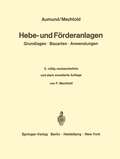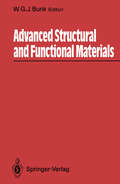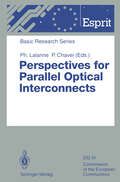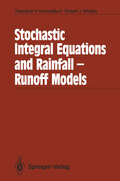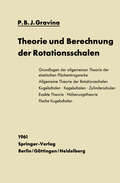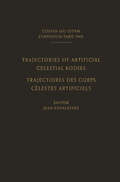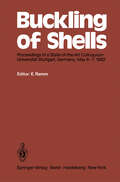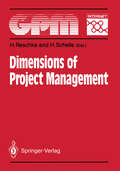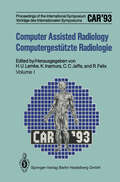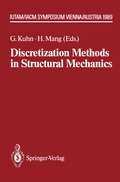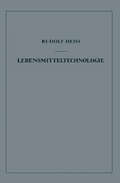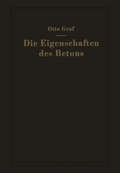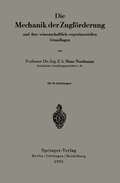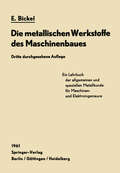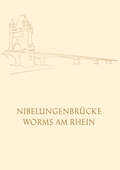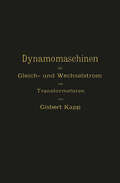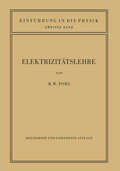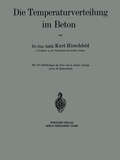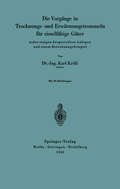- Table View
- List View
Diskrete Orthogonaltransformationen: Algorithmen und Flußgraphen für die Signalverarbeitung
by Philipp W. Besslich Tian LuField Theory Concepts: Electromagnetic Fields. Maxwell’s Equations grad, curl, div. etc. Finite-Element Method. Finite-Difference Method. Charge Simulation Method. Monte Carlo Method
by Adolf J. Schwab"Field Theory Concepts" is a new approach to the teaching and understanding of field theory. Exploiting formal analo- gies of electric, magnetic, and conduction fields and introducing generic concepts results in a transparently structured electomagnetic field theory. Highly illustrative terms alloweasyaccess to the concepts of curl and div which generally are conceptually demanding. Emphasis is placed on the static, quasistatic and dynamic nature of fields. Eventually, numerical field calculation algorithms, e.g. Finite Element method and Monte Carlo method, are presented in a concise yet illustrative manner.
Berechnung und Gestaltung von Metallfedern (Konstruktionsbücher #3)
by Siegfried GrossJ. Das Wesen und die kennzeichnenden Eigenschaften der Federn Alle festen Körper besitzen mehr oder minder große Elastizität oder Fedrigkeit, d. h. das Bestreben, nach Verformungen, die sie unter der Einwirkung äußerer Kräfte erfahren haben, wieder ihre ursprüngliche Gestalt anzunehmen. In dieser Eigenschaft liegt das Wesen der Feder begründet. Als Federn im engeren Sinne sind Vorrichtungen anzusprechen, die durch zweck entsprechende Formgebung und Verwendung hochelastischen Baustoffes eigens da für geschaffen sind, vermöge ihrer elastischen Formänderung mechanische Arbeit in potentielle Energie umzuformen und wieder in mechanische Arbeit zurückzu verwandeln. Hieraus entspringt die Eignung der Federn zur Arbeitsspeicherung, zur Milderung von Stößen, zur Abfederung oder Steuerung bewegter Massen und, wegen der gesetzmäßigen Abhängigkeit zwischen Kraft und Formänderung, zur Kraftmessung. 11. Baustoffe und Bauarten Bauart und Baustoff richten sich in erster Linie nach dem Verwendungszweck. Der wichtigste Werkstoff ist Stahl von hoher Festigkeit. Besonderen Anforde rungen, wie Hitze- oder Korrosionsbeständigkeit, Antimagnetismus, geringer Wärmedehnung und Unabhängigkeit des elastischen Verhaltens von der Tempera tur kann man durch geeignete Zusammensetzung des Stahles Rechnung tragen. Ihnen werden zum Teil auch Federwerkstoffe wie Messing, Bronze und andere Le gierungen von Nichteisenmetallen gerecht. Daneben sind Federn im Gebrauch, welche die elastischen Eigenschaften nichtmetallischer Stoffe wie Gummi, Holz, Kork und Luft ausnutzen. Das vorliegende Buch behandelt lediglich Federn aus Metall und im besonderen aus Stahl. 1. Stahl. (Vornorm DIN 17220 enthält ein Verzeichnis aller Normen, die Feder stähle betreffen.) Stahl kann durch Kaltverformen (Ziehen oder Walzen) oder durch Vergüten (d. h. Härten und Anlassen) auf Federhärte gebracht werden.
Einführung in die Korngrößenmeßtechnik: Korngrößenanalyse Kennzeichnung von Korngrößenverteilungen Oberflächenbestimmung, Probenahme Staubmeßtechnik
by Wilhelm BatelEntstaubungstechnik: Grundlagen Verfahren Meßwesen
by Wilhelm BatelEntstaubung ist das Entfernen oder Abtrennen von Teilchen der 3 3 Größe zwischen etwa 10- bis 10 fllll, die in Gasen dispergiert sind. Dementsprechend beschäftigt sich die Entstaubungstechnik insbeson dere mit der Konstruktion und dem Einsatz von Maschinen und Appa raten zur Entstaubung, die man unter dem Begriff Entstauber oder Staubabscheider zusammenfaßt. Das vorliegende Buch hat zum Ziel, eine Einführung in dieses Gebiet zu geben. Es will dem Ingenieur, der im Rahmen seiner Tätigkeit mit Fragen der Entstaubung in Berührung kommt, die Möglichkeit geben, sich in kurzer Zeit eine übersicht über das Gebiet und das entsprechende Grundwissen zu verschaffen. Das Buch, das aus meiner Vorlesung an der TH Aachen entstanden ist, wendet sich aber auch an den Studenten der Verfahrenstechnik und verwandter Fachrichtungen. Die Entstaubungstechnik wird nicht als ein eigenes und in sich ab geschlossenes Gebiet aufgefaßt, sondern als ein Teilgebiet der Verfahrens technik. Hiervon leitet sich auch die Auswahl und die Behandlung des Stoffes ab. Im Schwerpunkt werden die technisch-physikalischen Vor gänge in den Entstaubern behandelt, die die Grundlage für die Kon struktion und die Entwicklung bilden. über einige Anwendungsbei spiele werden die Aufgaben und die wichtigsten Bedingungen für die Entstaubung aufgezeigt. Da eine Bewertung und Auslegung der Ent stauber letztlich nur in Verbindung mit der Staubmeßtechnik möglich ist, wird auch dieses Gebiet behandelt.
Advanced Structural and Functional Materials: Proceedings of an International Seminar Organized by Deutsche Forschungsanstalt für Luft- und Raumfahrt (DLR), Köln, June 1991
by Wolfgang G. J. BunkEngineering materials are mainly used for structures. Therefore high-strength, stiffness and sufficient toughness are of prime importance. For a long time engineers thought first in terms of metals. Ma terial scientists developed alloys tailored to the needs of in dustry. Ceramics are known to be brittle and therefore not suitable in the first place for structural application under stress. Polymers with their low modulus became attractive when rein forced with high-strength fibres. Composites processed by poly mer, metal or ceramic matrices and high-strength reinforcements have been introduced into many sectors of industry. Engineering materials for structural applications fulfil a function: they withstand high stresses, temperatures, fatigue, creep etc. But usually we do not call them functional materials. Functional material serve applications apart from classical engineering fields. Electricity conducting materials, semi conductors, memory alloys and others are called functional materials. Both categories of materials structural and functional - cover the aspects of the DLR-Seminar 1991 on "Advanced structural and functional materials". in research and The seminar is focused on advanced materials development or at the edge of being introduced into the market. dual character: Preference was given to materials with a structural and functional, some of them more structural, some more functional in their potential. It was necessary to select typical and representative families of during the years by R + D activities somewhat matured mate rials. It was not intended to cover all possible innovations in a two half-days seminar.
Perspectives for Parallel Optical Interconnects (ESPRIT Basic Research Series)
by Philippe Lalanne Pierre ChavelThis volume is a monograph on parallel optical interconnects. It presents not only the state of-the-art in this domain but also the necessary physical and chemical background. It also provides a discussion of the potential for future devices. Both experts and newcomers to the area will appreciate the authors' proficiency in providing the complete picture of this rapidly growing field. Optical interconnects are already established in telecommunications and should eventually find their way being applied to chip and even gate level connections in integrated systems. The inspiring environment of the Basic Research Working Group on Optical Information Technology WOIT (3199), together with the excellent and complementary skills of its participants, make this contribution highly worthwhile. G. Metakides Table of contents 1 Perspectives for parallel optical interconnects: introduction . . . . . . . . . . . . . . . . . . . . . . . . . l Pierre Chavel and Philippe lAlanne 1. 1 Optical Interconnects and ESPRIT BRA WOIT . . . . . . . . . . . . . . . . . . . . . . . . . . . . . . . . . . . . . . . . . 1 1. 2 What are optical interconnects? . . . . . . . . . . . . . . . . . . . . . . . . . . . . . . . . . . . . . . . . . . . . . . . . . . . . . . . . . . . . . . . . . . . . 2 1. 3 Optical interconnects: how ? . . . . . . . . . . . . . . . . . . . . . . . . . . . . . . . . . . . . . . . . . . . . . . . . . . . . . . . . . . . . . . . . . . . . . . . . . 3 1. 3. 1 Passive devices . . . . . . . . . . . . . . . . . . . . . . . . . . . . . . . . . . . . . . . . . . . . . . . . . . . . . . . . . . . . . . . . 3 1. 3. 2 Active devices . . . . . . . . . . . . . . . . . . . . . . . . . . . . . . . . . . . . . . . . . . . . . . . . . . . . . . . . . . . . . . . . . . 4 1. 3. 3 Schemes for parallel optical interconnects . . . . . . . . . . . . . . . . . . . . . . . . . . . . . . . . . . 5 1. 3. 4 Limits of optical interconnects . . . . . . . . . . . . . . . . . . . . . . . . . . . . . . . . . . . . . . . . . . . . . . . 6 1. 4 Optical interconnects: why ? . . . . . . . . . . . . . . . . . . . . . . . . . . . . . . . . . . . . . . . . . . . . . . . . . . . . . . . . . . . . . . . . . . . . . . . . 6 Acknowledgetnents . . . . . . . . . . . . . . . . . . . . . . . . . . . . . . . . . . . . . . . . . . . . . . . . . . . . . . . . . . . . . . . . . . . . . . . . . . . . . . . . . . . . . . . . . . . . . . . 8 References . . . . . . . . . . . . . . . . . . . . . . . . . . . . . . . . . . . . . . . . . . . . . . . . . . . . . . . . . . . . . . . . . . . . . . . . . . . . . . . . . . . . . . . . . . . . . . . . . . . . . . . . . . . . . . 8 First Section: Components Part 1. 1 Passive interconnect components 2 Free space interconnects . . . . . . . . . . . . . . . . . . . . . . . . . . . . . . . . . . . . . . . . . . . . . . . . . . . . . . . . . . . . . . . . . . . . . . . . . . . . . . . . . . . . . . . . 11 Philippe Lalanne and Pierre ChaveZ 2. 1 Introduction: 3D optical interconnects . . . . . . . . . . . . . . . . . . . . . . . . . . . . . . . . . . . . . . . . . . . . . . . . . . . . . . 11 2. 2 Optical free space channels and their implementations . . . . . . . . . . . . . . . . . . . . . . . . . . . 12 2. 2. 1 Diffraction and degrees of freedom . . . . . . . . . . . . . . . . . . . . . . . . . . . . . . . . . . . . . . . . 12 2. 2. 2 Two Qasic interconnect setups . . . . . . . . . . . . . . . . . . . . . . . . . . . . . . . . . . . . . . . . . . . . .
Stochastic Integral Equations and Rainfall-Runoff Models
by Theodore V. Hromadka II Robert J. WhitleyThe subject of rainfall-runoff modeling involves a wide spectrum of topics. Fundamental to each topic is the problem of accurately computing runoff at a point given rainfall data at another point. The fact that there is currently no one universally accepted approach to computing runoff, given rainfall data, indicates that a purely deter ministic solution to the problem has not yet been found. The technology employed in the modern rainfall-runoff models has evolved substantially over the last two decades, with computer models becoming increasingly more complex in their detail of describing the hydrologic and hydraulic processes which occur in the catchment. But despite the advances in including this additional detail, the level of error in runoff estimates (given rainfall) does not seem to be significantly changed with increasing model complexity; in fact it is not uncommon for the model's level of accuracy to deteriorate with increasing complexity. In a latter section of this chapter, a literature review of the state-of-the-art in rainfall-runoff modeling is compiled which includes many of the concerns noted by rainfall-runoff modelers. The review indicates that there is still no deterministic solution to the rainfall-runoff modeling problem, and that the error in runoff estimates produced from rainfall-runoff models is of such magnitude that they should not be simply ignored.
Trajectories of Artificial Celestial Bodies as Determined from Observations / Trajectoires des Corps Celestes Artificiels Déterminées D’après les Observations: Proceedings of a Symposium Held in Paris, April 20–23, 1965
by J. KovalevskyIn May 1962 the International Union of Theoretical and Applied Mechanics (IUTAM) organized a symposium in Paris on the theory of the movement of the Earth's artificial satellites designated to confront the results of the first spatial experiences with the mechanical point of view. The papers submitted during this meeting have been published in 1963 in a collection entitled "Dynamics of Satellites" by Springer Verlag. During the last three years the importance of studies pertaining to the dynamics of artificial satellites has continued to increase, and many results due to observations have led to a deeper knowledge of the field of forces in which these objects move, particularly the field of gravitation of the Earth, the forces due to pressure of radiation, friction of the atmosphere, etc . . . A new symposium seemed therefore suitable to determine these recent advances. However, this time it appeared appropriate to consider it more from the point of view of the interpretation obtained from the results of observations (determination of orbits and forces existing) than from the point of view of the theory of motion. For this reason the complete title of the second symposium is as follows: "Trajectories of Artificial Celestial Bodies, as Determined from Observations".
Buckling of Shells: Proceedings of a State-of-the-Art Colloquium, Universität Stuttgart, Germany, May 6–7, 1982
by Ekkehard RammThin shells are very popular structures in many different branches of engineering. There are the domes, water and cooling towers, the contain ments in civil engineering, the pressure vessels and pipes in mechanical and nuclear engineering, storage tanks and platform components in marine and offshore engineering, the car bodies in the automobile industry, planes, rockets and space structures in aeronautical engineering, to mention only a few examples of the broad spectrum of application. In addition there is the large applied mechanics group involved in all the computational and experimental work in this area. Thin shells are in a way optimal structures. They play the role of·the "primadonnas" among all kinds of structures. Their performance can be extraordinary, but they can also be very sensitive. The susceptibility to buckling is a typical example. David Bushnell says in his recent review paper entitled "Buckling of Shells - Pitfall for DeSigners": "To the layman buckling is a mysterious, perhaps even awe inspiring phenomenon that transforms objects originally imbued with symmetrical beauty into junk".
Dimensions of Project Management: Fundamentals, Techniques, Organization, Applications
by Hasso Reschke Heinz SchelleProjects of very different natures are continuously changing the world in which we live. Project management offers the right instruments to solve the multitude of problems that arise during the life of a project from its beginning to its completion. No space satellite could be designed, no computer program developed, no skyscraper built, and no company organized efficiently without PM. In honor of the 65th birthday of R.W. Gutsch, 29 authors from 16 countries have contributed to this publication. It covers the fundamentals of project management as well as the PM techniques and software, PM organization and human factors and applications in effectively managing projects. The contributions demonstrate the enormous progress that has taken place in PM within the past years in a language and style which is understandable for project managers in both industrialized and developing countries.
Computer Assisted Radiology / Computergestützte Radiologie: Proceedings of the International Symposium / Vorträge des Internationalen Symposiums CAR'93 Computer Assisted Radiology
by Heinz U. LemkeCAR is a symposium and exhibition covering the impact of computer and communication systems applied to radiology and other medical disciplines, which use digital imaging for diagnosis and therapy planning. CAR '93 also provides tutorials, but more emphasis is given to a broad variety of specific problems related to medical/technical issues in digital imaging. This is achieved through in-depth presentations of results of current medical imaging projects on a worldwide basis.
Discretization Methods in Structural Mechanics: IUTAM/IACM Symposium Vienna/Austria, 5.–9.6.1989 (IUTAM Symposia)
by Günther Kuhn Herbert MangThe advent of the digital computer has given great impetus to the development of modern discretization methods in structural mechanics. The young history of the finite element method (FEM) reflects the dramatic increase of computing speed and storage capacity within a relatively short period of time. The history of the boundary element method (BEM) is still younger. Presently, intense scientific efforts aimed at extending the range of application of the BEM can be observed. More than 10 years ago, O.C. Zienkiewicz and his co-workers published the first papers on the coupling of FE and BE discretizations of subregions of solids for the purpose of exploiting the complementary advantages of the two discretization methods and reducing their disadvantages. The FEM has revolutionized structural analysis in industry as well as academia. The BEM has a fair share in the continuation of this revolution. Both discretization methods have become a domain of vigorous, world-wide research activities. The rapid increase of the number of specialized journals and scientific meetings indicates the remarkable increase of research efforts in this important subdolll.ain of computational ulechanics. Several discussions of this situation in the Committee for Discretization Methods ill Solid Mechanics of the Society for Applied Mathematics and Mechanics (GAMM) resulted in the plan to submit a proposal to the General Assembly of the International Union of Theoretical and Applied Mechanics (IUTAM) to sponsor a pertinent IUTAM Symposium.
Lebensmitteltechnologie: Einführung in die Verfahrenstechnik der Lebensmittelverarbeitung
by Rudolf HeissDie Eigenschaften des Betons: Versuchsergebnisse und Erfahrungen zur Herstellung und Beurteilung des Betons
by Otto GrafDie Mechanik der Zugförderung und ihre wissenschaftlich-experimentellen Grundlagen
by Hans NormannDie vorliegende Arbeit ist eine wohl zum ersten Male erscheinende kurzgefaßte Mechanik der Zugförderung und ihrer wissenschaftlich-ex perimentellen Grundlagen, sowohl in der positiven Richtung der wirk samen Zugkraft für alle Betriebsarten, wie in der negativen der Bremsung. über diesen Gegenstand könnte man unter Heranziehung des gesamten in- und ausländischen Schrifttums an sich einen stattlichen Band schreiben. Aber für die Einsicht in die inneren Zusammenhänge und eine verläßliche Urteils bildung ist eine solche lexikalische Ausführlich keit nicht vonnöten. Und der Leserkreis, an den sich das Buch wendet, wird sie, z. T. auch schon rein zeitlich, gar nicht wünscherJ. . Ich denke dabei an die Eisenbahnbeamten des oberen, namentlich maschinentech nischen Dienstes, denen eine zusammenfassende Darlegung der ihnen notwendigen Theorie willkommen sein dürfte, und an die Ingenieure der Lokomotivfabriken und Fahrzeugbauanstalten, die gern wissen möchten, was man von den Lokomotiven im Betrieb erwartet und welche Rolle Wagen und Bremsen dort spielen. Selbst befähigte Beamte und Ange stellte des gehobenen mittleren Dienstes könnten sich wohl an den Stoff wagen. Vor allem denke ich auch an die Technischen Hochschulen und ihre dem Eisenbahnmaschinenwesen zuneigenden Studierenden, die meist gar keine Vorlesung des vorliegenden Inhalts zu hören bekommen und daher zu sehr nur an das Konstruktive denken, während das Leben der Eisenbahn wesentlich im Betrieb besteht, der sich auf systematischer wissenschaftlicher Grundlage aufbauen muß.
